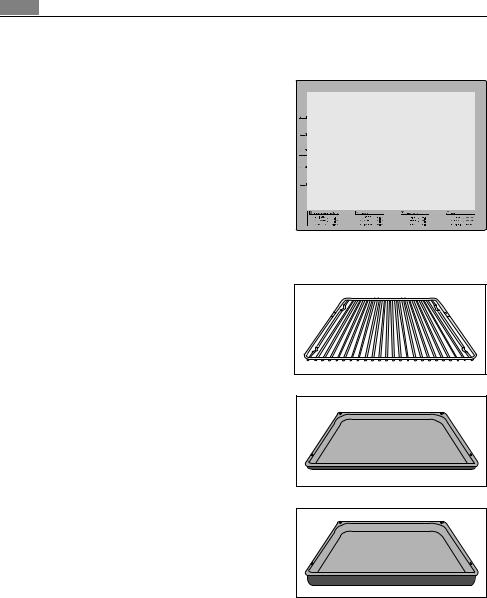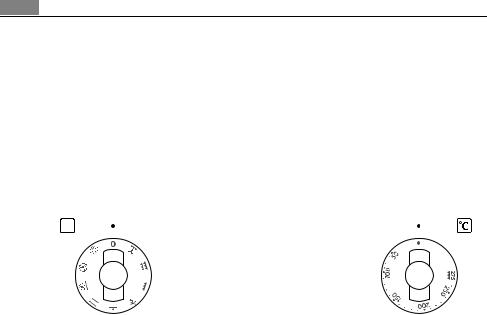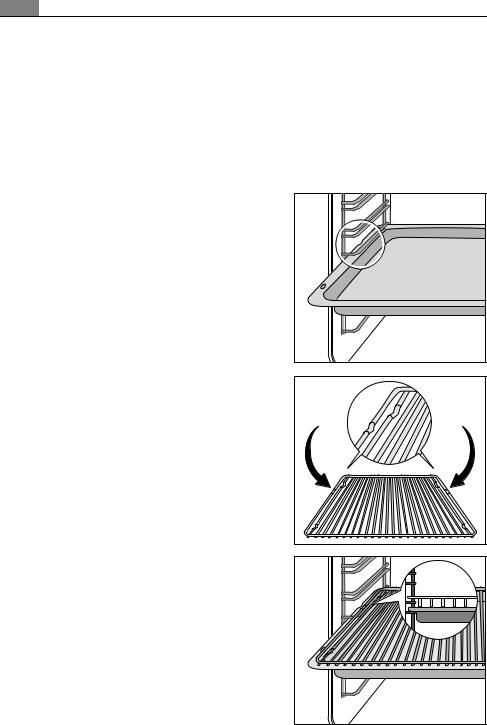Aeg-electrolux B4000-5-LG DE R08 Manual
B4000-5_LG
User manual |
Built-In Electric Oven |

2
Dear Customer
Thank you for choosing one of our high-quality products.
With this appliance you will experience the perfect combination of functional design and cutting edge technology.
Convince yourself that our appliances are engineered to deliver the best performance and control - indeed we are setting the highest standards of excellence.
In addition to this you find environmental and energy saving aspects as an integral part of our products.
To ensure optimal and regular performance of your appliance please read this instruction manual carefully. It will enable you to navigate all processes perfectly and most efficiently.
To refer to this manual any time you need to, we recommend you to keep it in a safe place. And please pass it to any future owner of the appliance.
We wish you much joy with your new appliance.
The following symbols are used in this user manual:
1Important information concerning your personal safety and information on how to avoid damaging the appliance.
3General information and tips
2Environmental information

Contents 3
Contents
Operating Instructions |
5 |
Safety instructions |
5 |
|
|
Description of the Appliance |
7 |
|
|
General Overview |
7 |
Control Panel |
7 |
Oven Features |
8 |
Oven accessories |
8 |
Before Using for the first time |
9 |
|
|
Initial Cleaning |
9 |
Using the Oven |
10 |
|
|
Switching the Oven On and Off |
10 |
Oven Functions |
11 |
Inserting the Oven Shelf, Baking Tray and Roasting Pan |
12 |
Inserting/Removing the Fat Filter |
13 |
Uses, Tables and Tips |
14 |
|
|
Baking |
14 |
Baking table |
16 |
Table for Bakes and Gratins |
21 |
Frozen Ready Meals Table |
22 |
Roasting |
23 |
Roasting table |
23 |
Grill Sizes |
25 |
Grilling table |
25 |
Defrosting |
26 |
Defrosting table |
26 |
Drying |
27 |
Making Preserves |
28 |
Cleaning and Care |
29 |
|
|
Outside of the appliance |
29 |
Oven interior |
29 |
Accessories |
29 |
Fat Filter |
29 |
Shelf Support Rails |
30 |
Oven Lighting |
31 |
Oven Ceiling |
32 |
Oven door |
33 |
Oven door glass |
35 |

4 Contents
What to do if … |
38 |
|
|
Disposal |
39 |
|
|
Installation Instructions |
40 |
|
|
Safety information for the installer |
40 |
Guarantee/Customer Service |
44 |
|
|
Service |
47 |
Operating Instructions |
|
5 |
|
|
|
Operating Instructions
1 Safety instructions
Electrical safety
•This appliance must be only connected by a registered electrician.
•In the event of a fault or damage to the appliance: Take the fuses out or switch off.
•Repairs to the appliance must only be carried out by qualified service engineers. Considerable danger may result from improper repairs. If repairs become necessary, please contact our Customer Services or your dealer.
Child Safety
• Never leave children unsupervised when the appliance is in use.
Safety whilst Using
•People (including children) who, because of their physical, sensory or mental capabilities or their inexperience or ignorance are not able to use the device safely, should not use this device without supervision or instruction by a responsible person.
•This appliance is intended to be used for cooking, roasting and baking food in the home.
•Take care when connecting electric appliances to sockets nearby. Do not allow connecting leads to come into contact with or to catch beneath the hot oven door.
•Warning: Risk of burns! The interior of the oven becomes hot during use.
•Using ingredients containing alcohol in the oven may create an alcohol-air mixture that is easily ignited. In this case, open the door carefully. Do not have embers, sparks or naked flames in the vicinity when opening the door.
3Information on acrylamides
According to the latest scientific knowledge, intensive browning of food, especially in products containing starch, can constitute a health risk due to acrylamides. Therefore we recommend cooking at the lowest possible temperatures and not browning foods too much.

6 Safety instructions
How to avoid damage to the appliance
•Do not line the oven with aluminium foil and do not place baking trays, pots, etc. on the oven floor, as the heat that builds up will damage the oven enamel.
•Fruit juices dripping from the baking tray will leave stains, which you will not be able to remove. For very moist cakes, use a deep tray.
•Do not put any strain on the oven door when open.
•Never pour water directly into the oven when it is hot. This could cause damage to or discolouration of the enamel.
•Rough handling, especially around the edges of the front panel, can cause the glass to break.
•Do not store any flammable materials inside the oven. These could ignite when the oven is switched on.
•Do not store any moist foods inside the oven. This could damage the oven enamel.
•After switching off the cooling fan, do not keep uncovered dishes in the oven. Moisture may condense in the oven interior or on the glass doors and may get into the units.
3Note on enamel coating
Changes in the colour of the oven’s enamel coating as a result of use do not affect the appliance’s suitability for normal and correct use. They therefore do not constitute a defect in the sense of the warranty law.

Description of the Appliance |
|
7 |
|
|
|
Description of the Appliance
General Overview
Control panel
Door handle
Full glass door
Control Panel
Oven Power Indicator Temperature Pilot Light
|
|
|
|
|
|
|
|
|
|
|
|
|
|
|
|
|
|
|
|
|
|
|
|
|
|
|
|
|
|
|
|
|
|
|
|
Oven Functions |
Temperature selector |
||||||||||

8 Description of the Appliance
Oven Features
Inside of door
On the inside of the oven door you will find the numbers of the different oven shelves.
You will also find some brief information about the oven's functions, recommended shelves and temperatures for cooking the most popular dishes.
Oven accessories
Oven shelf
For cookware, cake tins, roasts and grilled foods.
Baking tray
For cakes and biscuits.
Roasting Pan
For baking and roasting or as a pan for collecting fat.
Before Using for the first time |
|
9 |
|
|
|
Before Using for the first time
Initial Cleaning
Before using the oven for the first time you should clean it thoroughly.
1Caution: Do not use any caustic, abrasive cleaners! The surface could be damaged.
3To clean metal fronts use commercially available cleaning agents.
1.Turn the oven function switch to oven lighting  .
.
2.Remove all accessories and the shelf support rails and wash them with warm water and washing up liquid.
3.Then wash out the oven with warm water and washing-up liquid, and dry.
4.Wipe the front of the appliance with a damp cloth.

10 Using the Oven
Using the Oven
Switching the Oven On and Off
Oven Power Indicator |
Temperature Pilot Light |
||||
|
|
|
|
|
|
|
|
|
|
|
|
|
|
|
|
|
|
|
|
|
|
|
|
|
|
|
|
|
|
|
|
|
|
|
|
|
|
|
|
|
|
Oven Functions |
Temperature selector |
1.Turn the oven functions dial to the desired function.
2.Turn the temperature selector to the desired temperature. The power indicator is lit as long as the oven is in operation.
The temperature pilot light is lit as long as the oven is heating up.
3.To turn the oven off, turn the oven functions dial and the temperature selector to the Off position.
3Cooling fan
The fan switches on automatically in order to keep the appliance’s surfaces cool. When the oven is switched off, the fan continues to run to cool the appliance down, then switches itself off automatically.

Using the Oven 11
Oven Functions
The oven has the following functions:
Oven function |
Application |
|
|
Light |
Using this function you can light up the oven interior, e.g. for |
|
cleaning. |
Convection with |
For baking on up to three oven levels at the same time. |
ring heating |
Set the oven temperatures 20-40 °C lower than when using |
element |
Conventional. |
Pizza setting |
For baking on one oven level dishes that require more inten- |
|
sive browning and a crispy base. |
|
Set the oven temperatures 20-40 °C lower than when using |
|
Conventional. |
Conventional |
For baking and roasting on one oven level. |
Bottom heat |
For baking cakes with crispy or crusty bases. |
Defrost |
For defrosting e. g. flans and gateaux, butter, bread, fruit or |
|
other frozen foods. |
Grill |
For grilling flat foodstuffs placed in the middle of the grill |
|
and for toasting. |
Dual grill |
For grilling flat foodstuffs in large quantities and for toast- |
|
ing. |
Rotitherm |
For roasting larger joints of meat or poultry on one level. |
|
The function is also suitable for gratinating and browning. |
|
|

12 Using the Oven
Inserting the Oven Shelf, Baking Tray and Roasting Pan
3Shelf runner safety and anti-tip device
As a shelf runner safety device, all insertable components have a small curved indentation at the bottom on the right and left-hand edge.
Always insert insertable components so that this indentation is at the back of the oven interior. This indentation is also important for preventing the insertable components from tipping.
Inserting the baking tray or roasting pan
Push the baking tray or roasting pan between the guide bars of the selected oven level.
Inserting the oven shelf:
Insert the oven shelf so that the feet point downwards.
Push the oven shelf between the guide bars of the selected oven level.
3The high rim around the oven shelf is an
additional device to prevent cookware from slipping.
Inserting the oven shelf and roasting pan together
Lay the oven shelf on the roasting pan.
Push the roasting pan between the guide bars of the selected oven level.

Using the Oven 13
Inserting/Removing the Fat Filter
The fat filter protects the rear wall heating element against splashes of fat when roasting.
Inserting the fat filter
Holding the fat filter by the tab, insert the two retainers into the opening on the rear wall of the oven (fan opening) from the top downwards.
Removing the fat filter
Take hold of the tab on the fat filter and remove by pulling upwards.

14 Uses, Tables and Tips
Uses, Tables and Tips
Baking
Oven function: Convection with ring heating element  or Conventional
or Conventional 
Baking tins
•For Conventional  dark metal and non-stick tins are suitable.
dark metal and non-stick tins are suitable.
•For Convection with ring heating element  bright metal tins are also suitable.
bright metal tins are also suitable.
Oven levels
•Baking with Conventional  is possible on one oven level.
is possible on one oven level.
•With Convection with ring heating element  you can bake on up to 3 baking trays at the same time:
you can bake on up to 3 baking trays at the same time:
1 baking tray: e.g. oven level 3
1 cake tin:
e.g. oven level 1
2 baking trays:
z. g., oven levels 1 and 3
3 baking trays:
oven levels 1, 3 and 5

Uses, Tables and Tips 15
General Instructions
•Insert the tray with the bevel at the front.
•With Conventional  or Convection with ring heating element
or Convection with ring heating element  you can also bake with two tins next to one another on the oven shelf at the same time. This does not significantly increase baking time.
you can also bake with two tins next to one another on the oven shelf at the same time. This does not significantly increase baking time.
3When frozen foods are used the trays inserted may distort during cooking. This is due to the large difference in temperature between the freezing temperature and the temperature in the oven. Once the trays have cooled the distortion will disappear again.
How to use the Baking Tables
The tables give the required temperature settings, baking times and oven shelf levels for a selection of typical dishes.
•Temperatures and baking times are for guidance only, as these will depend on the consistency of pastry, dough or mixture, the amount and the type of baking tin.
•We recommend using the lower temperature the first time and then if necessary, for example, if a deeper browning is required, or baking time is too long, selecting a higher temperature.
•If you cannot find the settings for a particular recipe, look for the one that is most similar.
•If baking cakes on baking trays or in tins on more than one level, baking time may be extended by 10-15 minutes.
•Moist recipes (for example, pizzas, fruit flans, etc.) are baked on one level.
•Cakes and pastries at different heights may brown at an uneven rate at first. If this occurs, please do not change the temperature setting. Different rates of browning even out as baking progresses.
•Your new oven may bake or roast differently to your previous appliance. So adapt your normal settings (temperature, cooking times) and oven shelf levels to the recommendations in the following tables.
2With longer baking times, the oven can be switched off about 10 minutes before the end of baking time, to make use of the residual heat.
Unless otherwise stated, the values given in the tables assume that cooking is started with the oven cold.
